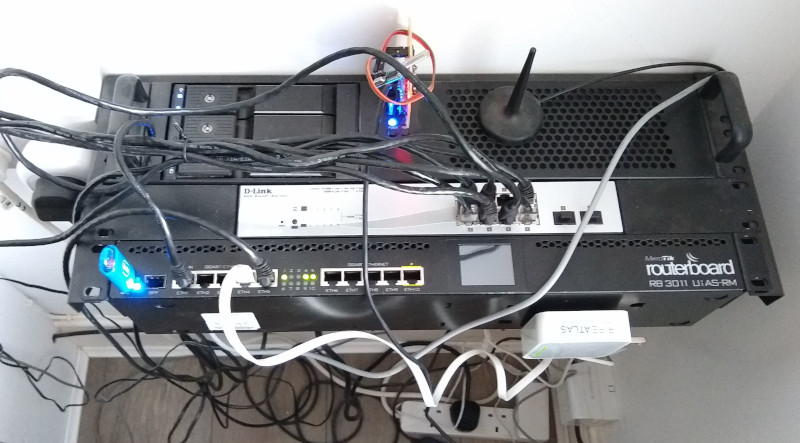The netbox.netbox collection from Ansible Galaxy
provides several modules to update NetBox objects:
- name: create a device in NetBox
netbox_device:
netbox_url: http://netbox.local
netbox_token: s3cret
data:
name: to3-p14.sfo1.example.com
device_type: QFX5110-48S
device_role: Compute Switch
site: SFO1
However, if NetBox is not your source of truth, you may want to
ensure it stays in sync with your configuration management
database by removing outdated devices or IP addresses. While it
should be possible to glue together a playbook with a query, a loop
and some filtering to delete unwanted elements, it feels clunky,
inefficient and an abuse of YAML as a programming language. A specific
Ansible module solves this issue and is likely more flexible.
Code
The module has the following signature and it syncs NetBox with
the content of the provided YAML file:
netbox_sync:
source: netbox.yaml
api: https://netbox.example.com
token: s3cret
The synchronized objects are:
- sites,
- manufacturers,
- device types,
- device roles,
- devices, and
- IP addresses.
In our environment, the YAML file is generated from our configuration
management database and contains a set of devices and a list of IP
addresses:
devices:
ad2-p6.sfo1.example.com:
datacenter: sfo1
manufacturer: Cisco
model: Catalyst 2960G-48TC-L
role: net_tor_oob_switch
to1-p6.sfo1.example.com:
datacenter: sfo1
manufacturer: Juniper
model: QFX5110-48S
role: net_tor_gpu_switch
# […]
ips:
- device: ad2-p6.example.com
ip: 172.31.115.18/21
interface: oob
- device: to1-p6.example.com
ip: 172.31.115.33/21
interface: oob
- device: to1-p6.example.com
ip: 172.31.254.33/32
interface: lo0.0
# […]
The network team is not the sole tenant in NetBox. While adding new
objects or modifying existing ones should be relatively safe, deleting
unwanted objects can be risky. The module only deletes objects it did
create or modify. To identify them, it marks them with a specific tag,
cmdb. Most objects in NetBox accept tags.
Module definition
Starting from the skeleton described in the previous article, we define the module:
module_args = dict(
source=dict(type='path', required=True),
api=dict(type='str', required=True),
token=dict(type='str', required=True, no_log=True),
max_workers=dict(type='int', required=False, default=10)
)
result = dict(
changed=False
)
module = AnsibleModule(
argument_spec=module_args,
supports_check_mode=True
)
It contains an additional optional arguments defining the number of
workers to talk to NetBox and query the existing objects in parallel
to speedup the execution.
Abstracting synchronization
We need to synchronize different object types, but once we have a list
of objects we want in NetBox, the grunt work is always the same:
- check if the objects already exist,
- retrieve them and put them in a form suitable for comparison,
- retrieve the extra objects we don’t want anymore,
- compare the two sets, and
- add missing objects, update existing ones, delete extra ones.
We code these behaviours into a Synchronizer abstract class. For
each kind of object, a concrete class is built with the appropriate
class attributes to tune its behaviour and a wanted() method to
provide the objects we want.
I am not explaining the abstract class code here. Have a look at the
source if you want.
As a starter, here is how we define the class synchronizing the tags:
class SyncTags(Synchronizer):
app = "extras"
table = "tags"
key = "name"
def wanted(self):
return {"cmdb": dict(
slug="cmdb",
color="8bc34a",
description="synced by network CMDB")}
The app and table attributes defines the NetBox objects we want
to manipulate. The key attribute is used to determine how to lookup
for existing objects. In this example, we want to lookup tags using
their names.
The wanted() method is expected to return a dictionary mapping
object keys to the list of wanted attributes. Here, the keys are tag
names and we create only one tag, cmdb, with the provided slug,
color and description. This is the tag we will use to mark the objects
we create or modify.
If the tag does not exist, it is created. If it exists, the provided
attributes are updated. Other attributes are left untouched.
We also want to create a specific tenant for objects accepting such an
attribute (devices and IP addresses):
class SyncTenants(Synchronizer):
app = "tenancy"
table = "tenants"
key = "name"
def wanted(self):
return {"Network": dict(slug="network",
description="Network team")}
Synchronizing sites
We also need to synchronize the list of sites. This time, the
wanted() method uses the information provided in the YAML file: it
walks the devices and builds a set of datacenter names.
class SyncSites(Synchronizer):
app = "dcim"
table = "sites"
key = "name"
only_on_create = ("status", "slug")
def wanted(self):
result = set(details["datacenter"]
for details in self.source['devices'].values()
if "datacenter" in details)
return {k: dict(slug=k,
status="planned")
for k in result}
Thanks to the use of the only_on_create attribute, the specified
attributes are not updated if they are different. The goal of this
synchronizer is mostly to collect the references to the different
sites for other objects.
>>> pprint(SyncSites(**sync_args).wanted())
{'sfo1': {'slug': 'sfo1', 'status': 'planned'},
'chi1': {'slug': 'chi1', 'status': 'planned'},
'nyc1': {'slug': 'nyc1', 'status': 'planned'}}
Synchronizing manufacturers, device types and device roles
The synchronization of manufacturers is pretty similar, except we do
not use the only_on_create attribute:
class SyncManufacturers(Synchronizer):
app = "dcim"
table = "manufacturers"
key = "name"
def wanted(self):
result = set(details["manufacturer"]
for details in self.source['devices'].values()
if "manufacturer" in details)
return {k: {"slug": slugify(k)}
for k in result}
Regarding the device types, we use the foreign attribute linking
a NetBox attribute to the synchronizer handling it.
class SyncDeviceTypes(Synchronizer):
app = "dcim"
table = "device_types"
key = "model"
foreign = {"manufacturer": SyncManufacturers}
def wanted(self):
result = set((details["manufacturer"], details["model"])
for details in self.source['devices'].values()
if "model" in details)
return {k[1]: dict(manufacturer=k[0],
slug=slugify(k[1]))
for k in result}
The wanted() method refers to the manufacturer using its key
attribute. In this case, this is the manufacturer name.
>>> pprint(SyncManufacturers(**sync_args).wanted())
{'Cisco': {'slug': 'cisco'},
'Dell': {'slug': 'dell'},
'Juniper': {'slug': 'juniper'}}
>>> pprint(SyncDeviceTypes(**sync_args).wanted())
{'ASR 9001': {'manufacturer': 'Cisco', 'slug': 'asr-9001'},
'Catalyst 2960G-48TC-L': {'manufacturer': 'Cisco',
'slug': 'catalyst-2960g-48tc-l'},
'MX10003': {'manufacturer': 'Juniper', 'slug': 'mx10003'},
'QFX10002-36Q': {'manufacturer': 'Juniper', 'slug': 'qfx10002-36q'},
'QFX10002-72Q': {'manufacturer': 'Juniper', 'slug': 'qfx10002-72q'},
'QFX5110-32Q': {'manufacturer': 'Juniper', 'slug': 'qfx5110-32q'},
'QFX5110-48S': {'manufacturer': 'Juniper', 'slug': 'qfx5110-48s'},
'QFX5200-32C': {'manufacturer': 'Juniper', 'slug': 'qfx5200-32c'},
'S4048-ON': {'manufacturer': 'Dell', 'slug': 's4048-on'},
'S6010-ON': {'manufacturer': 'Dell', 'slug': 's6010-on'}}
The device roles are defined like this:
class SyncDeviceRoles(Synchronizer):
app = "dcim"
table = "device_roles"
key = "name"
def wanted(self):
result = set(details["role"]
for details in self.source['devices'].values()
if "role" in details)
return {k: dict(slug=slugify(k),
color="8bc34a")
for k in result}
Synchronizing devices
A device is mostly a name with references to a role, a model, a
datacenter and a tenant. These references are declared as foreign keys
using the synchronizers defined previously.
class SyncDevices(Synchronizer):
app = "dcim"
table = "devices"
key = "name"
foreign = {"device_role": SyncDeviceRoles,
"device_type": SyncDeviceTypes,
"site": SyncSites,
"tenant": SyncTenants}
remove_unused = 10
def wanted(self):
return {name: dict(device_role=details["role"],
device_type=details["model"],
site=details["datacenter"],
tenant="Network")
for name, details in self.source['devices'].items()
if {"datacenter", "model", "role"} <= set(details.keys())}
The remove_unused attribute is a safety implemented to fail if we
have to delete more than 10 devices: this may be the indication there
is a bug somewhere, unless one of your datacenter suddenly caught
fire.
>>> pprint(SyncDevices(**sync_args).wanted())
{'ad2-p6.sfo1.example.com': {'device_role': 'net_tor_oob_switch',
'device_type': 'Catalyst 2960G-48TC-L',
'site': 'sfo1',
'tenant': 'Network'},
'to1-p6.sfo1.example.com': {'device_role': 'net_tor_gpu_switch',
'device_type': 'QFX5110-48S',
'site': 'sfo1',
'tenant': 'Network'},
[…]
Synchronizing IP addresses
The last step is to synchronize IP addresses. We do not attach them to
a device. Instead, we specify the device names in the
description of the IP address:
class SyncIPs(Synchronizer):
app = "ipam"
table = "ip-addresses"
key = "address"
foreign = {"tenant": SyncTenants}
remove_unused = 1000
def wanted(self):
wanted = {}
for details in self.source['ips']:
if details['ip'] in wanted:
wanted[details['ip']]['description'] = \
f"{details['device']} (and others)"
else:
wanted[details['ip']] = dict(
tenant="Network",
status="active",
dns_name="", # information is present in DNS
description=f"{details['device']}: {details['interface']}",
role=None,
vrf=None)
return wanted
There is a slight difficulty: NetBox allows duplicate IP addresses,
so a simple lookup is not enough. In case of multiple matches, we
choose the best by preferring those tagged with cmdb, then those
already attached to an interface:
def get(self, key):
"""Grab IP address from NetBox."""
# There may be duplicate. We need to grab the "best".
results = super(Synchronizer, self).get(key)
if len(results) == 0:
return None
if len(results) == 1:
return results[0]
scores = [0]*len(results)
for idx, result in enumerate(results):
if "cmdb" in result.tags:
scores[idx] += 10
if result.interface is not None:
scores[idx] += 5
return sorted(zip(scores, results),
reverse=True, key=lambda k: k[0])[0][1]
Getting the current and wanted states
Each synchronizer is initialized with a reference to the Ansible
module, a reference to a pynetbox’s API object, the data contained
in the provided YAML file and two empty dictionaries for the current
and expected states:
source = yaml.safe_load(open(module.params['source']))
netbox = pynetbox.api(module.params['api'],
token=module.params['token'])
sync_args = dict(
module=module,
netbox=netbox,
source=source,
before={},
after={}
)
synchronizers = [synchronizer(**sync_args) for synchronizer in [
SyncTags,
SyncTenants,
SyncSites,
SyncManufacturers,
SyncDeviceTypes,
SyncDeviceRoles,
SyncDevices,
SyncIPs
]]
Each synchronizer has a prepare() method whose goal is to compute
the current and wanted states. It returns True in case of a
difference:
# Check what needs to be synchronized
try:
for synchronizer in synchronizers:
result['changed'] |= synchronizer.prepare()
except AnsibleError as e:
result['msg'] = e.message
module.fail_json(**result)
Applying changes
Back to the skeleton described in the previous article, the last step is to apply the changes if there
is a difference between these states. Each synchronizer registers the
current and wanted states in sync_args["before"][table] and
sync_args["after"][table] where table is the name of the table for
a given NetBox object type. The diff object is a bit elaborate as
it is built table by table. This enables Ansible to display the name
of each table before the diff representation:
# Compute the diff
if module._diff and result['changed']:
result['diff'] = [
dict(
before_header=table,
after_header=table,
before=yaml.safe_dump(sync_args["before"][table]),
after=yaml.safe_dump(sync_args["after"][table]))
for table in sync_args["after"]
if sync_args["before"][table] != sync_args["after"][table]
]
# Stop here if check mode is enabled or if no change
if module.check_mode or not result['changed']:
module.exit_json(**result)
Each synchronizer also exposes a synchronize() method to apply
changes and a cleanup() method to delete unwanted objects. Order is
important due to the relation between the objects.
# Synchronize
for synchronizer in synchronizers:
synchronizer.synchronize()
for synchronizer in synchronizers[::-1]:
synchronizer.cleanup()
module.exit_json(**result)
The complete code is available on GitHub. Compared to using
netbox.netbox collection, the logic is written in
Python instead of trying to glue Ansible tasks together. I believe
this is both more flexible and easier to read, notably when trying to
delete outdated objects. While I did not test it, it should also be
faster. An alternative would have been to reuse code from the
netbox.netbox collection, as it contains similar primitives.
Unfortunately, I didn’t think of it until now. 😶

















 Like
Like 

































